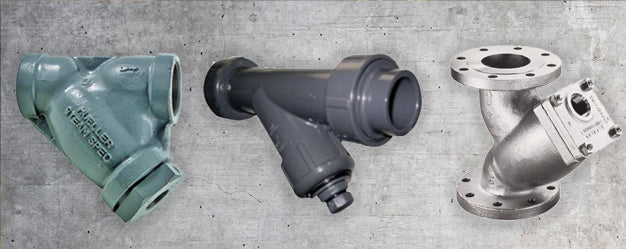It’s important to choose the right type of Y strainer for specific piping systems. Y strainers are made of various materials, including metals and plastics. They are an essential part of pipelines in helping prevent solids and debris from mixing into the liquid in a flowline. They also help protect the longevity of other equipment in piping systems and prevent downtime from unscheduled maintenance and repairs by eliminating unwanted solids and particles before they get to crucial pieces like pumps, steam traps, flow meters, and control valves.
Different Body Materials Used
The materials Y strainers are made of determine the types of conditions and applications they are best suited for. They can be used in such applications as steam, liquid, natural gas, and air pipelines. Below are some of the most used Y strainer materials and suggested applications.
Stainless Steel

Stainless steel Y strainers are commonly used for applications in which freedom from contamination and resistance to high corrosion is required. It’s the preferred material for food, chemical, and pharmaceutical industries. However, stainless steel may be more expensive than some of the other Y strainer material options. (View products)
Cast Iron
Cast iron Y strainers are typically used in piping systems that do not have high pressure and high temperatures and where the system isn’t exposed to high thermal or mechanical shock. Cast iron is the most commonly used strainer body. It’s used for bigger-sized potable water lines and various non-potable water systems as well as a variety of other product and process uses.
Carbon Steel

Y strainers that are made with carbon steel are used with high pressure and temperatures and are very resistant to thermal and mechanical stress, because they are strong and durable. They are also used for applications that have a fire risk. Carbon steel bodies are used primarily in the oil and petrochemical industry. (View products)
Bronze

Bronze Y strainers are an effective option for removing dirt, rust, and adhesives from piping systems. Bronze body y strainers are often used in brackish, saline, and seawater applications, as well as for potable water services. However, it is more expensive than some of the other options. (View products)
Brass

Brass Y strainers are an affordable solution for various applications. Brass is often used for upstream installations to protect regulators, pumps, and control valves from unwanted solids like rust and pipe scale. (View products.)
PVC and CPVC

Y strainers made from PVC or CPVC (polyvinyl chloride or chlorinated polyvinyl chloride) are an ideal choice for removing dirt, debris, and other solids from commercial and industrial piping systems. They can withstand high pressures and can be installed vertically or horizontally, making installation convenient. While PVC can only tolerate temperatures up to 140° degrees Fahrenheit, CPVC can withstand temperatures as high as 200° Fahrenheit. They have excellent corrosion and chemical resistance. PVC and CPVC are versatile materials, making these types of Y strainers suitable for a wide range of applications. Additionally, they are inexpensive compared to other options. (View products here and here)
Can You Mix Metal & PVC (Plastic) Strainers?
With so many different materials, you may wonder if you can mix metal and plastic components in piping systems. Perhaps you need to replace a Y strainer in a piping system that is metal. Plastic Y strainers are typically less expensive than those made of stainless steel or other metals. But, will it work to use a plastic Y strainer in a metal piping system?
Plastic Y strainers can be used in metal piping systems; however, it’s important to be aware of some factors that can affect how successful your application ends up being. When deciding whether to use a plastic Y strainer in a metal pipeline, there are three main considerations:
- Temperature and pressure rating. Often times, metal components are used in piping systems because of higher operating temperatures. If you plan to use a plastic Y strainer in a metal system, make sure that the temperature and pressure range of the application is within the plastic Y strainer’s acceptable range.
- Chemical resistance. It’s also important to consider the potential for shock pressure generation (water hammer) in the piping system, which could prove to be too harsh for a plastic Y strainer, causing damage and resulting in downtime and more maintenance. Look for things like a system flow rate that’s more than 8’ per second, positive displacement pumps, fast opening or closing actuated valves, quick starting pumps, and solenoid valves, before you mix materials in a piping system.
- Installation and stress. The stress that will be placed on the plastic Y strainer is a critical installation consideration. Stress can cause problems or damage right away, or it can accumulate over time and show up sometime in the future. So, it’s important to make sure that the metal and plastic components are properly aligned. If they have to be forced into place, there will be problems at some point. Additionally, be sure to watch out for misalignment of the mating pipe flanges, as well as oversize face-to-face dimensions of the flanges. To avoid thermal expansion, you may want to use expansion joints to compensate, or you can try installing plastic pipe on the outlet and inlet of the Y strainer to keep it from attaching directly to metal pipe.
Choosing the Right Material Type
Not all piping applications are the same. As a result, it’s important to choose the right pipeline components, made of the right type of material, for the specific job. Y strainers are available in various materials, including those highlighted above. You can see that each material is ideal for specific uses and types of piping systems. When you use Y strainers made of the right material for your pipeline, it helps ensure efficient operation, reduced downtime, and longer lifespans for crucial equipment.

